Complex Wavelets#
Notebook#
View in Jupyter-Notebook#

A quick example to compare different wavelets#
import numpy as np
import matplotlib.pyplot as plt
import spkit
print('spkit-version ', spkit.__version__)
import spkit as sp
from spkit.cwt import ScalogramCWT
from spkit.cwt import compare_cwt_example
x,fs = sp.load_data.eegSample_1ch()
t = np.arange(len(x))/fs
compare_cwt_example(x,t,fs=fs)
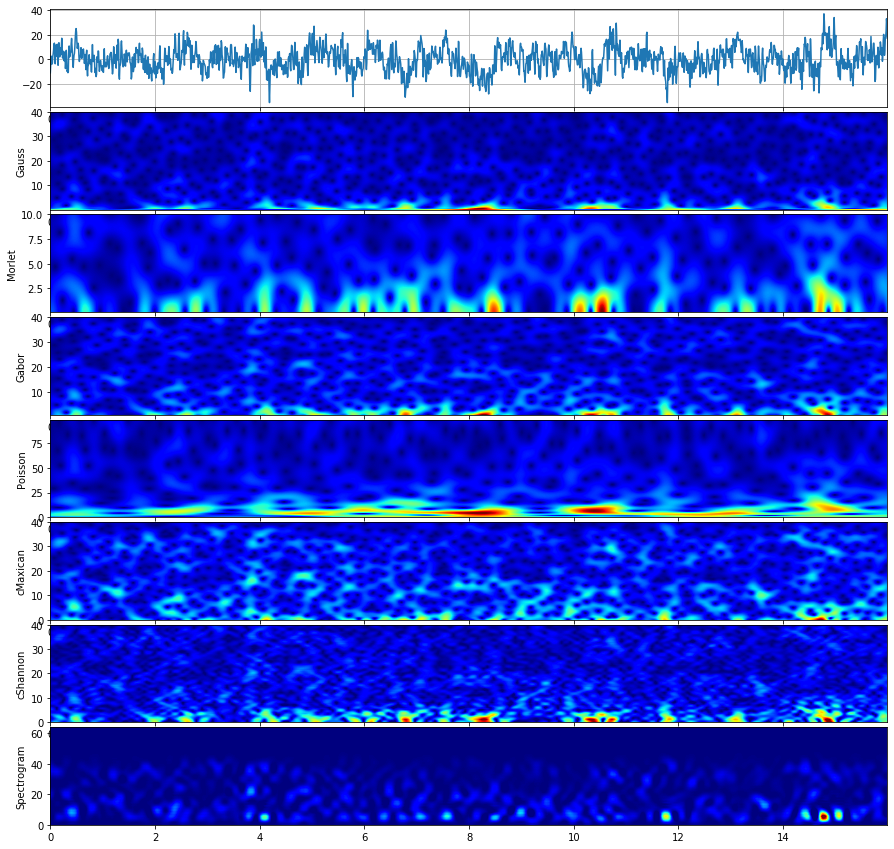

Gauss wavelet#
The Gauss Wavelet function in time and frequency domain are defined as \(\psi(t)\) and \(\psi(f)\) as below;
where
Parameters for a Gauss wavelet:
f0 - center frequency
Q - associated with spread of bandwidth, as a = (f0/Q)^2
import numpy as np
import matplotlib.pyplot as plt
import spkit
print('spkit-version ', spkit.__version__)
import spkit as sp
from spkit.cwt import ScalogramCWT
Parameters for a Gauss wavelet:
f0 - center frequency
Q - associated with spread of bandwidth, as a = (f0/Q)^2
Plot wavelet functions#
fs = 128 #sampling frequency
tx = np.linspace(-5,5,fs*10+1) #time
fx = np.linspace(-fs//2,fs//2,2*len(tx)) #frequency range
f01 = 2 #np.linspace(0.1,5,2)[:,None]
Q1 = 2.5 #np.linspace(0.1,5,10)[:,None]
wt1,wf1 = sp.cwt.GaussWave(tx,f=fx,f0=f01,Q=Q1)
f02 = 2 #np.linspace(0.1,5,2)[:,None]
Q2 = 0.5 #np.linspace(0.1,5,10)[:,None]
wt2,wf2 = sp.cwt.GaussWave(tx,f=fx,f0=f02,Q=Q2)
plt.figure(figsize=(15,4))
plt.subplot(121)
plt.plot(tx,wt1.T.real,label='real')
plt.plot(tx,wt1.T.imag,'--',label='image')
plt.xlim(tx[0],tx[-1])
plt.xlabel('time')
plt.ylabel('Q=2.5')
plt.legend()
plt.subplot(122)
plt.plot(fx,abs(wf1.T), alpha=0.9)
plt.xlim(fx[0],fx[-1])
plt.xlim(-5,5)
plt.xlabel('Frequency')
plt.show()
plt.figure(figsize=(15,4))
plt.subplot(121)
plt.plot(tx,wt2.T.real,label='real')
plt.plot(tx,wt2.T.imag,'--',label='image')
plt.xlim(tx[0],tx[-1])
plt.xlabel('time')
plt.ylabel('Q=0.5')
plt.legend()
plt.subplot(122)
plt.plot(fx,abs(wf2.T), alpha=0.9)
plt.xlim(fx[0],fx[-1])
plt.xlim(-5,5)
plt.xlabel('Frequency')
plt.show()


With a range of scale parameters#
f0 = np.linspace(0.5,10,10)[:,None]
Q = np.linspace(1,5,10)[:,None]
#Q = 1
wt,wf = sp.cwt.GaussWave(tx,f=fx,f0=f0,Q=Q)
plt.figure(figsize=(15,4))
plt.subplot(121)
plt.plot(tx,wt.T.real, alpha=0.8)
plt.plot(tx,wt.T.imag,'--', alpha=0.6)
plt.xlim(tx[0],tx[-1])
plt.xlabel('time')
plt.subplot(122)
plt.plot(fx,abs(wf.T), alpha=0.6)
plt.xlim(fx[0],fx[-1])
plt.xlim(-20,20)
plt.xlabel('Frequency')
plt.show()

Signal Analysis - EEG#
x,fs = sp.load_data.eegSample_1ch()
t = np.arange(len(x))/fs
print('shape ',x.shape, t.shape)
plt.figure(figsize=(15,3))
plt.plot(t,x)
plt.xlabel('time')
plt.ylabel('amplitude')
plt.xlim(t[0],t[-1])
plt.grid()
plt.show()

Scalogram with default parameters#
## With default setting of f0 and Q # f0 = np.linspace(0.1,10,100) # Q = 0.5
XW,S = ScalogramCWT(x,t,fs=fs,wType='Gauss',PlotPSD=True)
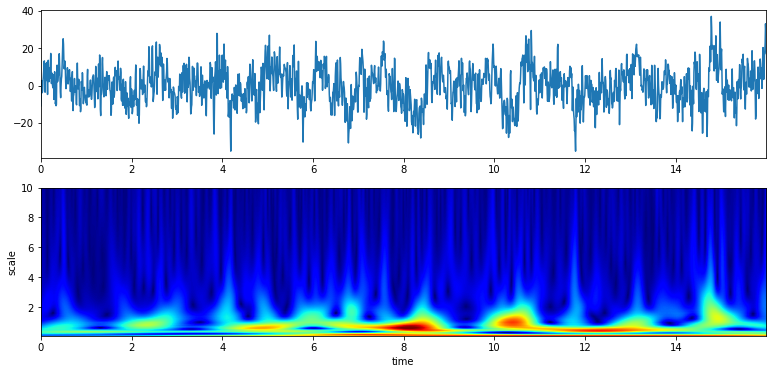
With a range of frequency and Q#
# from 0.1 to 10 Hz of analysis range and 100 points
f0 = np.linspace(0.1,10,100)
Q = np.linspace(0.1,5,100)
XW,S = ScalogramCWT(x,t,fs=fs,wType='Gauss',PlotPSD=True,f0=f0,Q=Q)
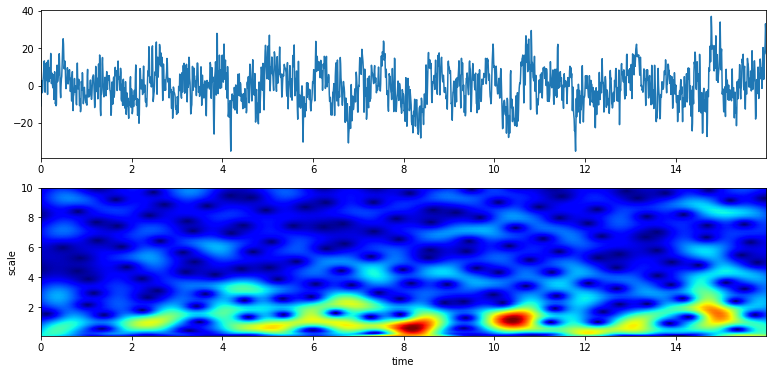
# from 5 to 10 Hz of analysis range and 100 points
f0 = np.linspace(5,10,100)
Q = np.linspace(1,4,100)
XW,S = ScalogramCWT(x,t,fs=fs,wType='Gauss',PlotPSD=True,f0=f0,Q=Q)
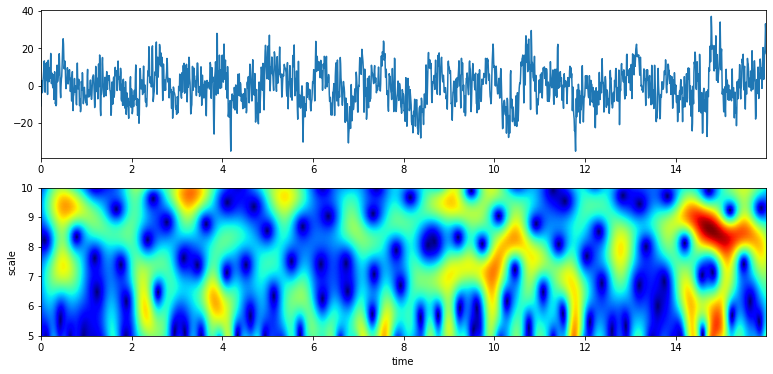
# With constant Q
f0 = np.linspace(5,10,100)
Q = 2
XW,S = ScalogramCWT(x,t,fs=fs,wType='Gauss',PlotPSD=True,f0=f0,Q=Q)
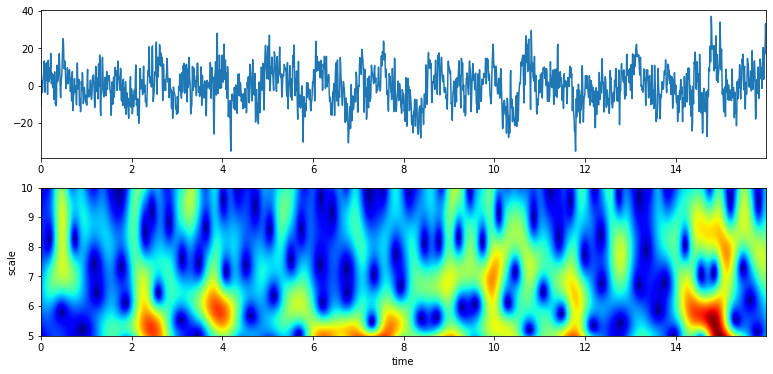
# From 12 to 24 Hz
f0 = np.linspace(12,24,100)
Q = 4
XW,S = ScalogramCWT(x,t,fs=fs,wType='Gauss',PlotPSD=True,f0=f0,Q=Q)
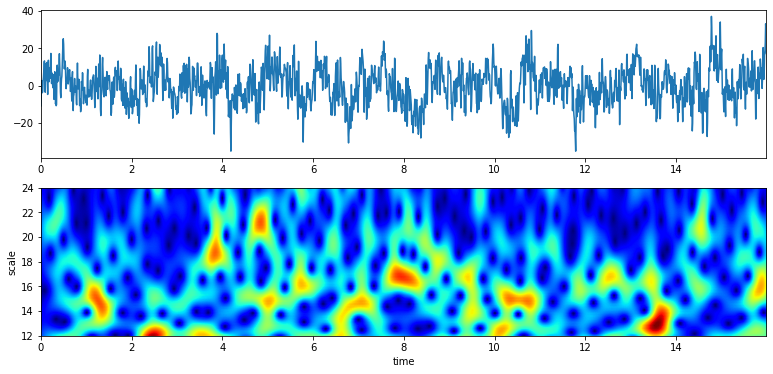
With a plot of analysis wavelets#
f0 = np.linspace(12,24,100)
Q = 4
XW,S = ScalogramCWT(x,t,fs=fs,wType='Gauss',PlotPSD=True,PlotW=True, f0=f0,Q=Q)

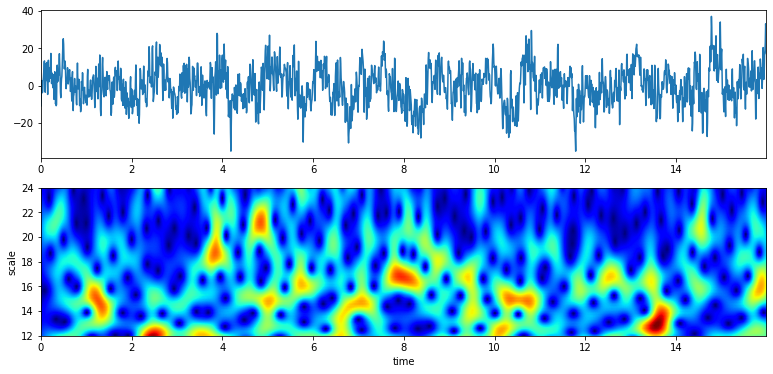
#TODO Speech/Audio Signal
Speech#
#TODO
Audio#
#TODO
Morlet wavelet#
#TODO
The Morlet Wavelet function in time and frequency domain are defined as \(\psi(t)\) and \(\psi(f)\) as below;
where
XW,S = ScalogramCWT(x,t,fs=fs,wType='Morlet',PlotPSD=True)
Gabor wavelet#
#TODO
The Gabor Wavelet function (technically same as Gaussian) in time and frequency domain are defined as \(\psi(t)\) and \(\psi(f)\) as below;
where \(a\) is oscilation rate and \(f_0\) is center frequency
XW,S = ScalogramCWT(x,t,fs=fs,wType='Gabor',PlotPSD=True)
Poisson wavelet#
Poisson wavelet is defined by positive integers ($n$), unlike other, and associated with Poisson probability distribution
The Poisson Wavelet function in time and frequency domain are defined as \(\psi(t)\) and \(\psi(f)\) as below;
#Type 1 (n)#
where
Admiddibility const \(C_{\psi} =\frac{1}{n}\) and \(w = 2\pi f\)
XW,S = ScalogramCWT(x,t,fs=fs,wType='Poisson',method = 1,PlotPSD=True)
#Type 2#
where
XW,S = ScalogramCWT(x,t,fs=fs,,wType='Poisson',method = 2,PlotPSD=True)
#Type 3 (n)#
where
XW,S = ScalogramCWT(x,t,fs=fs,wType='Poisson',method = 3,PlotPSD=True)
#TODO
Maxican wavelet#
Complex Mexican hat wavelet is derived from the conventional Mexican hat wavelet. It is a low-oscillation wavelet which is modulated by a complex exponential function with frequency \(f_0\) Ref..
The Maxican Wavelet function in time and frequency domain are defined as \(\psi(t)\) and \(\psi(f)\) as below;
where \(w = 2\pi f\) and \(w_0 = 2\pi f_0\)
XW,S = ScalogramCWT(x,t,fs=fs,wType='cMaxican',PlotPSD=True)
#TODO
Shannon wavelet#
Complex Shannon wavelet is the most simplified wavelet function, exploiting Sinc function by modulating with sinusoidal, which results in an ideal bandpass filter. Real Shannon wavelet is modulated by only a cos function Ref.
The Shannon Wavelet function in time and frequency domain are defined as \(\psi(t)\) and \(\psi(f)\) as below;
where
where \(\prod (x) = 1\) if \(x \leq 0.5\), 0 else and \(w = 2\pi f\) and \(w_0 = 2\pi f_0\)
XW,S = ScalogramCWT(x,t,fs=fs,wType='cShannon',PlotPSD=True)
#TODO